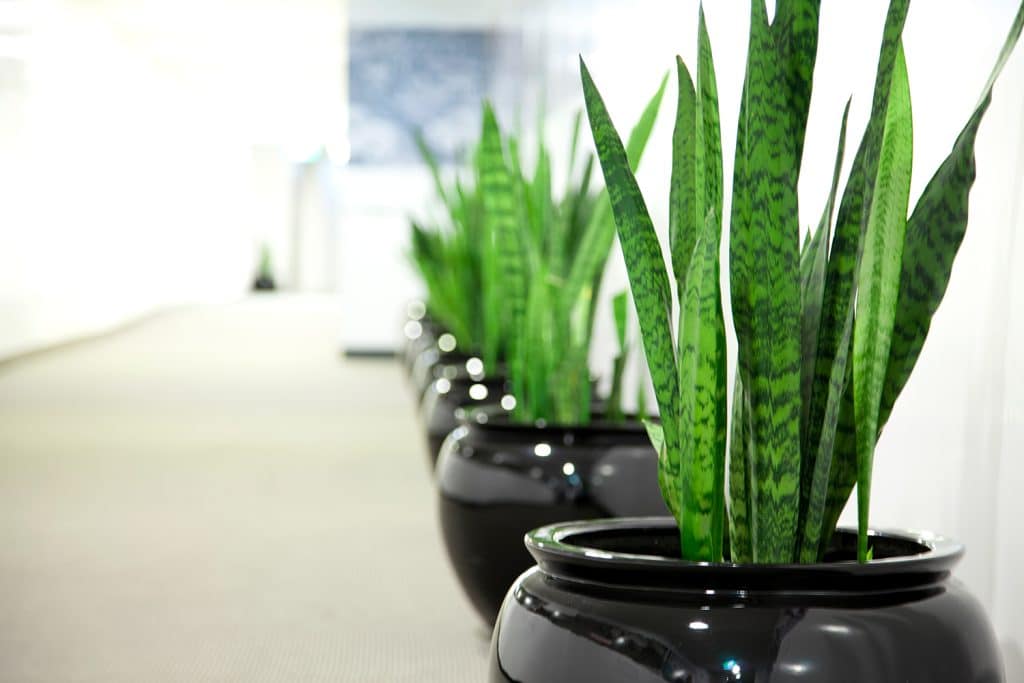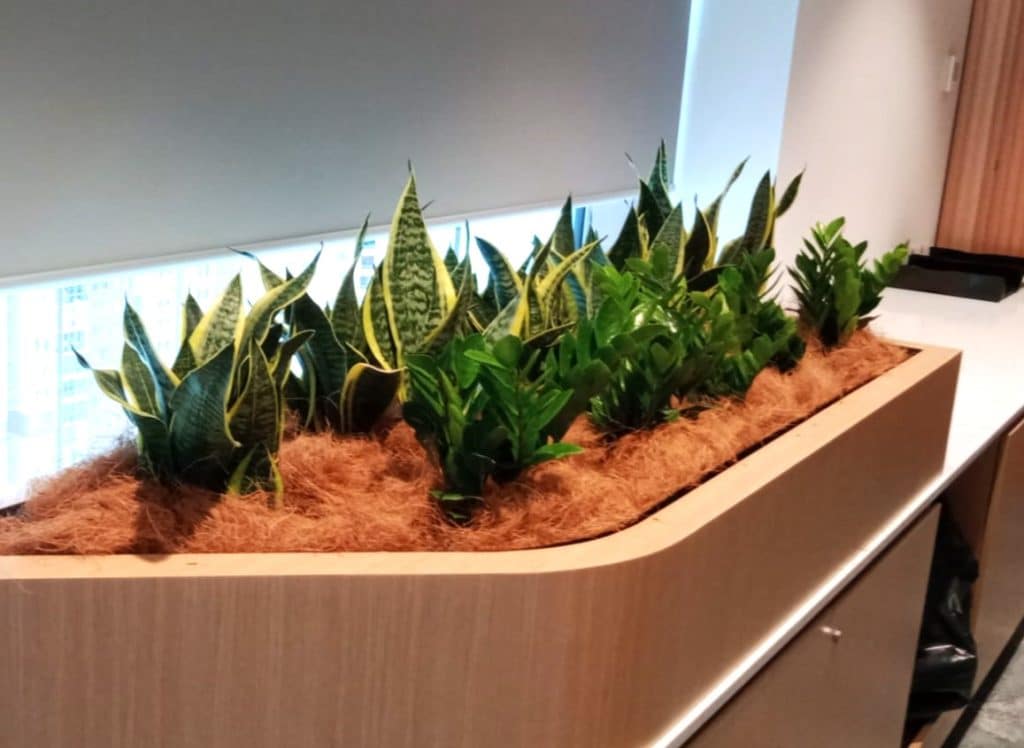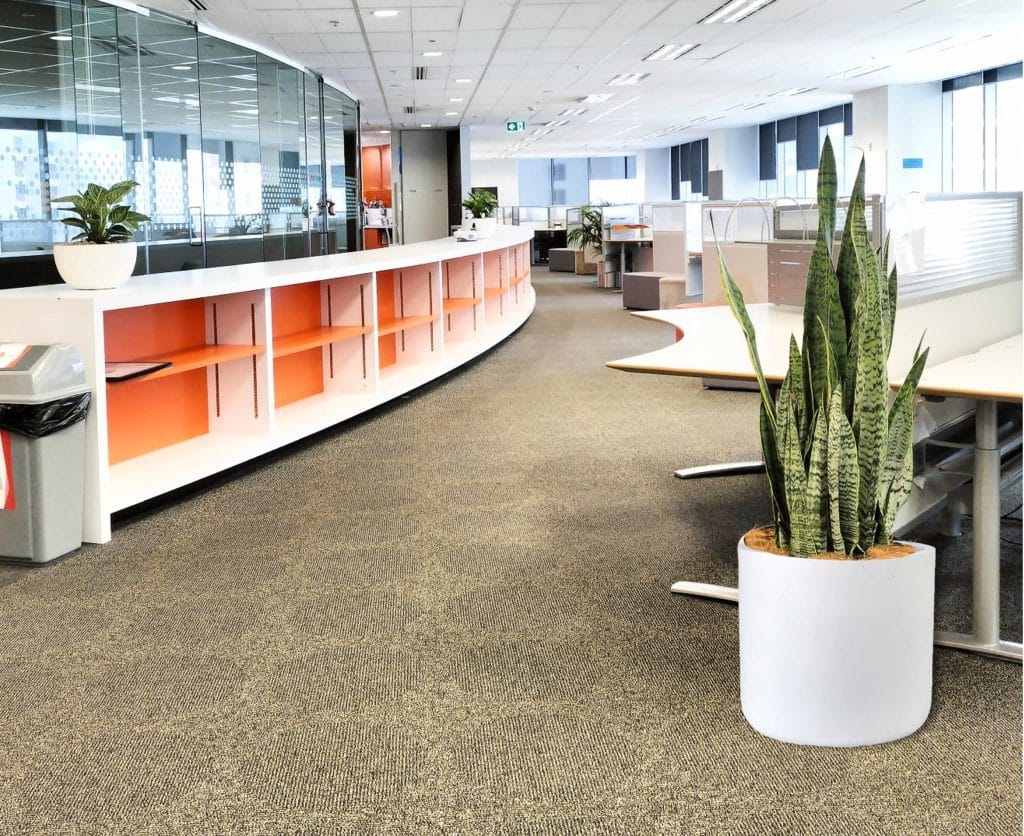If you’re looking for a simple office plant that still looks great, you’ll find it super easy to take care of snake plants! The snake plant, also known as Sansevieria or “mother-in-law’s tongue,” are extremely popular indoor plants, and it’s easy to see why – because indoor snake plant care is such a breeze. Known for their iconic upright leaves and remarkable hardiness, these striking plants grow well in areas with low sunlight and can go for months without water! Let’s find out more about Sansevieria snake plant care.

Are Snake Plants Easy to Care For?
You bet they are! When it comes to snake plant care, as you would find with any other common indoor plant, snake plants still need the essentials; however, the awesome thing is you really don’t need to put in too much effort at all!

The Benefits of Snake Plants – A Quick Snapshot
Low Maintenance: Forget about playing plant nanny, Sansevierias are the ultimate low-maintenance indoor plants. These bad boys only need a sip of water every now and then.
Air Purification: For an indoor space that’s toxin-free, you can’t go past snake plants. One of the best indoor plants for oxygen purification, they have no problem removing formaldehyde, benzene, and xylene out of your air.
Oxygen Production: Who needs a fancy air purifier? Unlike most other plants, Sansevierias perform their photosynthesis at night, releasing oxygen for better air quality. With that in mind, you might want to consider putting a snake plant in your bedroom too!
Adaptability: Bright light, low light, no problem – snake plants will adjust to any lighting situation with style.
Hardiness: Highly drought tolerant, apart from the odd leaf scarring, Sansevierias are almost indestructible!
Slow Growers: Because of their slow growth, with your Sansevieria snake plant care there’s no need to regularly re-pot every other month, making your life way easier.

How Do You Care for a Snake Plant?
The care of snake plants is pretty straightforward. However, by better understanding their specific needs you’ll be able to ensure they remain healthy and vibrant with no problem! Here are a few things to keep in mind for your indoor snake plant care:
- Watering: Don’t forget to water your snake plant at least every two weeks, or whenever the top two inches of soil feel dry to the touch. But remember, not too much, you want to avoid letting that water sit there for too long as it could cause root rot.
- Light: Snake plants are the light ninjas of the plant world. While they do thrive in bright, indirect sunlight, they are highly adaptable and can make the most of any light condition.
- Temperature: Sansevierias don’t mind being a little toasty, so try and keep it in a nice warm spot, ideally where the temperatures stay above 10°C.
- Repotting: Snake plants like their homes just right! So, if they look like they’re getting too big for their pots, try to save any repotting until the spring. You also don’t need any fancy dirt or fertiliser, just some simple houseplant compost will do the trick nicely!
- Cleaning: If your office or indoor space gets a little dusty, all you need to do is occasionally wipe the leaves with a clean, damp cloth to keep them dust-free and looking their best.
- Feeding: Feed your snake plant with liquid fertiliser about once a month during the spring and summer months. You can think of it like giving your plant a seasonal energy drink!
- You can grow more snake plants: Love the look of Sansevierias and want more? Use leaf cuttings or divide the snake plant to propagate. But be mindful though, because with variegated varieties you may not get their unique and cool patterns.

Does a Snake Plant Need Indirect Light?
They thrive in indirect sunlight but can also rock it in low light levels, making them perfect for your office cubicle or that shady corner that’s always been a little too gloomy. For their best performance, though, give them bright, indirect light – think of it as their spotlight on the plant Broadway stage!
Snake Plant Watering Tips to Prevent Root Rot
Overwatering is like kryptonite for your snake plant! To keep it happy and healthy, follow these watering tips:
Allow the Soil to Dry: Make sure you let the soil dry out completely before you water again. These plants are like the camel of the plant world – they prefer it dry and can handle drought better than a soggy soil bath.
Water Sparingly in Winter: When it’s cold outside, slow down on the watering. Your snake plant’s growth takes a winter nap and doesn’t need as much H2O. Think of it as the plant version of cutting back on hot cocoa!

The Best Temperature for Snake Plants
Because snake plants are used to drought, they do love a warm and toasty environment, and will ideally thrive in temperatures ranging from 21°C to 32°C. They can handle a bit of a cold air-conditioning but prolonged exposure to anything below 10°C is a big no-no. Also, for the best in snake plant care, their ideal humidity levels should range between 30% to 50%.
Related article: Plants that Absorb Humidity

Additional Tips for Sansevieria Snake Plant Care
As we’ve already mentioned, snake plant care is relatively easy, but there are a few other things you’ll want to keep in mind for proper Sansevieria snake plant care:
- Soil: You’ll want to use a well-draining potting mix to prevent root rot. A cactus or succulent mix works like magic. The ‘Laurentii’ variety sports fancy creamy yellow edges, but those can go green if you propagate from leaf cuttings – talk about a style change!
- Pot: Snake plants can reach up to a metre tall, making them the skyscrapers of the plant world. So, make sure you plant them in a pot that’s heavy enough in the bottom to weigh it down and stop it from falling over. You could add some white pebbles around the base of the snake plant which will also add a bit of contemporary style.
- Fertilisation: For the ultimate in snake plant care, feed it with a balanced, all-purpose fertiliser once a month during the growing season in spring and summer. Avoid fertilising in autumn and winter.
- Pest Control: Snake plants are generally pest-resistant, but occasionally, they may attract mealybugs or spider mites. Wipe the leaves with a damp cloth and use neem oil to treat infestations.
- Threat of Ingestion: Snake plants are mildly toxic if nibbled, so keep them out of reach of pets and small children. Indoor snake plant care is important, but so is protecting your furry friends and little humans.
- Repotting: Growing snake plants from cuttings? Use free-draining soil and know when to repot. It’s like moving them into a bigger, fancier home!
Seeing how easy it is to take care of snake plants, why wouldn’t you want to bring nature’s air fresheners into your office or indoor space!
Or better yet, leave all your indoor plant needs up to our team at The Plant Man!
Enjoy the beauty and benefits of plants in the office without lifting a finger. Contact us today to transform your Sydney office with our snake plant hire and snake plant care services.











